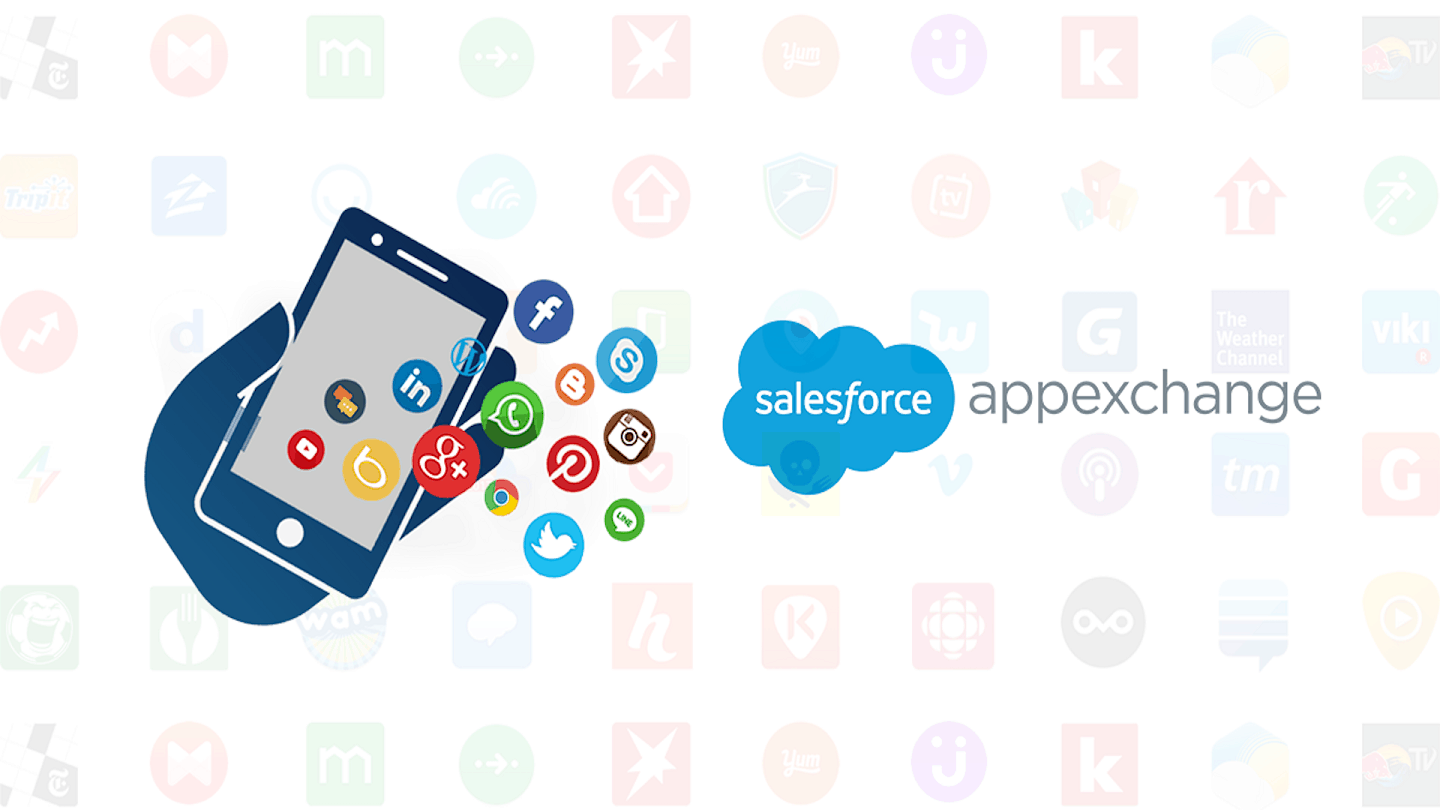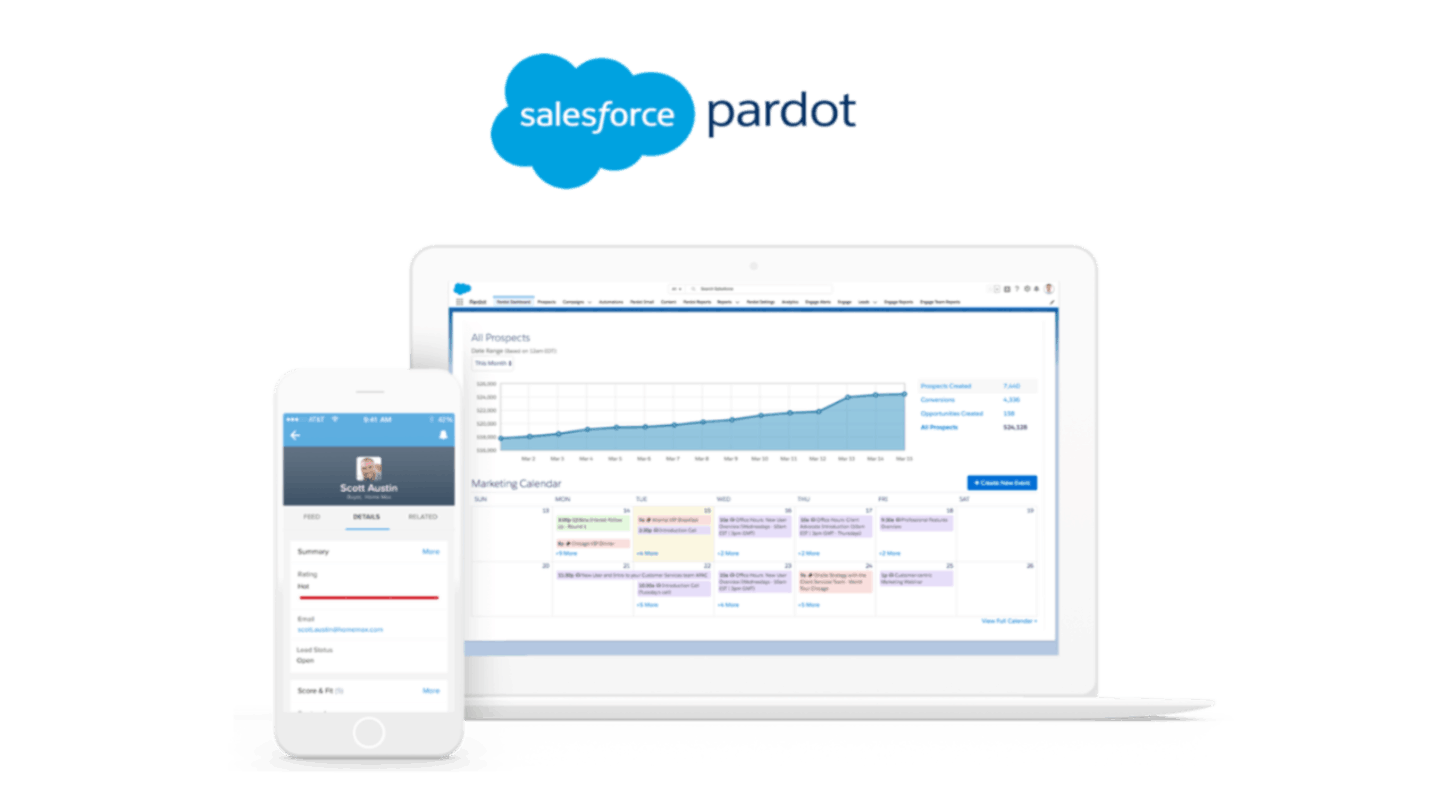Account Based Marketing
Account-Based Marketing (ABM) is a very promising new approach to B2B marketing.
In classic B2B marketing, you try to generate as many leads as possible and then sort them out. It’s the quantity that counts. The more leads you collect, the better: this is the credo of inbound marketing.
In the “ABM” approach, on the other hand, we focus on a small number of very high-value prospects that we seek to engage through ultra-personalised campaigns. It is quality that counts. This is known as “revenue expansion”: the bulk of your potential marginal revenue is in your existing customers. An approach well known to consultancies, for example.
ABM allows you to better focus your marketing efforts and minimise the waste of resources. If you are tired of spending time, energy and money trying to attract and engage leads that will never become customers, this article is for you.
Find out what you need to know about Account-Based Marketing.
What is Account-Based Marketing? [Definition]
Briefly summarised, Account-Based Marketing is a form of marketing that involves creating ultra-targeted, ultra-personalised campaigns to reach, and (re)convert, the most valuable leads. This approach is in contrast to traditional marketing, which consists of creating general campaigns to reach all potential customers in the market. Why is this?
- Because not all customers are the same and in some businesses it is more interesting to focus on those prospects that can generate the most revenue.
- Because companies, in general, waste too many resources targeting prospects who are unlikely to convert and/or who will not provide much value to the company (if they convert).
- Because in B2B, the purchasing decision is a collective one. Sometimes there are more than 10 or even 15 people involved in the decision-making process. To increase your chances of converting companies into customers, you need to take the time to identify and target all the company’s decision-makers.
Discover the best tools for generating leads from LinkedIn.
In a sense, Account-Based Marketing reverses the traditional conversion funnel of inbound marketing:
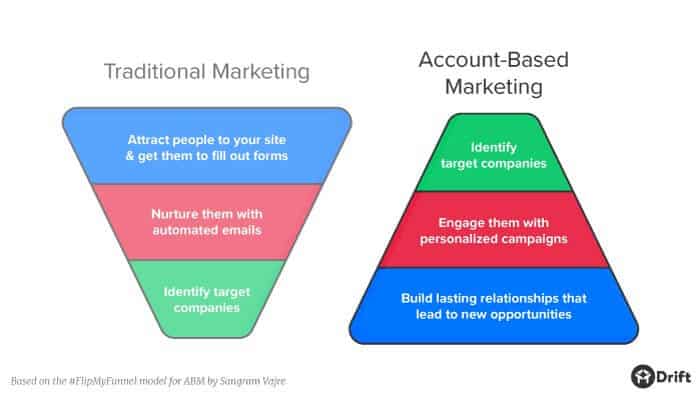
We are indeed dealing with two completely different ways of doing things:
- In classic marketing, the aim is to attract as many visitors as possible to your B2B site and to generate as many leads as possible via the form. To do this, you use content marketing, advertising campaigns, etc. Then, the leads obtained are heated by marketing automation scenarios. This is called lead nurturing. At the end of this lead heating process, which is also a qualification and scoring process, the leads are sorted, the “good” leads are identified, those that are worthwhile, those that can bring in a lot of money and/or have a high chance of converting. Finally, the “good leads” are passed on to the sales team, which is responsible for converting them into customers.
- In Account-Based Marketing, the perspective is reversed. The first step is to identify the right potential leads. What was the last step in traditional marketing becomes the first step in ABM. Once you have identified the key companies-accounts, you seek to engage them through ultra-targeted marketing campaigns. Once they become customers, we build a strong, long-term customer relationship.
In general, marketing teams are overwhelmed by low-value leads. With the Account-Based Marketing approach, this problem is solved at the root. ABM is “zero waste” or “zero waste” marketing.
In ABM, the focus is on identifying key accounts and building strong customer relationships. Rather than publishing blog post after blog post and creating general email campaigns, Account Based Marketing agencies and teams seek to create content for specific, identified prospects.
Discover the Top 10 email list cleaning tools.
Account-Based Marketing VS Inbound Marketing
Inbound marketing is the classic approach in B2B marketing. First of all, a note: the aim here is not to try to prove that account-based marketing is superior to inbound marketing – or the other way around. The main aim is to show that the two are different, but that they can be combined with each other.
In fact, ABM and Inbound Marketing do not have the same targets. Account-Based Marketing is relevant for the “big fish”, to target the big companies (or at least your biggest potential customers). Inbound Marketing is suitable for targeting the small or medium-sized fish.
The two approaches can be combined. Inbound marketing can be used to feed the ABM conversion funnel. For example, if a lead generated inbound turns out to be a key account, you can decide to switch the processing of this lead to the ABM approach. Conversely, ABM can be used to identify promising leads generated by inbound marketing. It is quite possible to conceive of a transition from Inbound Marketing to Account-Based Marketing.
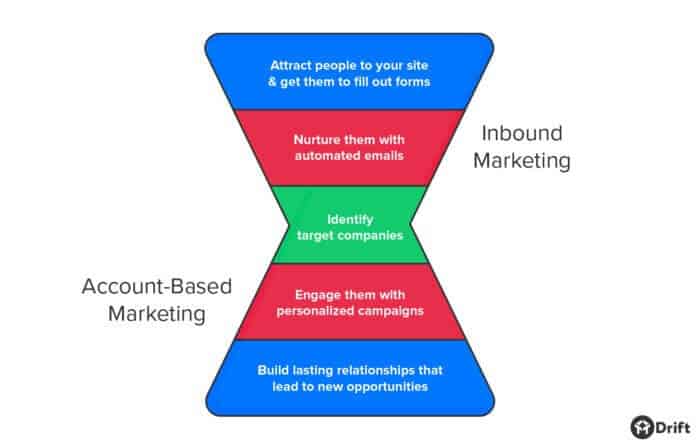
Find out how to build a Lead Scoring strategy.
The 3 main differences between Account-Based Marketing and Inbound Marketing
- ABM is “ultra-targeted” marketing. Rather than relying on mass campaigns to generate as many leads as possible, ABM focuses on a limited number of prospects, on those that are likely to generate the most revenue and/or convert the most easily – by creating ultra-personalised campaigns. To identify these high-value prospects, ABM builds ideal customer profiles, or personas.
- Account-Based Marketing focuses on accounts, not markets or sectors. Hence the name of this approach. ABM = Account-Based Marketing. ABM is based on a very good understanding of the target accounts, their needs and expectations in order to create ultra-personalised campaigns. Inbound marketing targets a lot of people – i.e. everyone in your market or industry.
- Account-Based Marketing targets both prospects and customers. ABM is not just an approach to lead generation and conversion. It is about building a strong customer relationship, retaining customers to generate more revenue from them.
4 reasons why Account-Based Marketing works
#1 It allows a better alignment between marketing and sales…
Since account-based marketing professionals focus on accounts and not individual leads, they end up speaking the same language as their sales colleagues. This leads to a better alignment of the marketing and sales teams.
For years, marketing in its traditional form has been trained to write and create campaigns for people in a particular market or industry. At the same time, sales people have been trained to focus on accounts that are likely to buy. By moving to an ABM approach, both marketing and sales focus on target accounts and pursue the same goal. There are no more barriers between the two. It is well known that companies with well aligned marketing and sales teams grow more on average than others.
Read our full guide to lead qualification.
#2 …More efficiency…
This point has already been made. Because it is ultra-targeted, because marketing efforts are focused on a small number of key accounts, ABM makes it possible to limit the waste of resources (financial, human, technical) to a minimum. Account-Based Marketing is marketing that aims for zero waste. If we want to use a metaphor, we can say that ABM is to harpoon fishing what classic marketing is to net fishing.
#3…An optimized customer experience…
In ABM, messages, content, contact moments and channels are ultra-personalised, based on in-depth knowledge of key accounts. Every touch point in the customer journey is personalised. This high degree of personalisation results in a much richer and more satisfying customer experience than traditional marketing can deliver.
#4…A Maximised King
The ROI of ABM campaigns is on average higher than that of traditional marketing campaigns. Several studies have proven this, such as this one. Marketing spends its time justifying its budgets. Of course, a study on the ROI of ABM will certainly not be enough to convince the decision-makers in your company. The best thing to do is to create a pilot programme to demonstrate that this approach generates a better ROI than your traditional marketing. You can test this approach in miniature, by identifying a few key accounts and starting to develop personalised campaigns.
Discover 20 high potential lead generation techniques.
The future of Account-Based Marketing
This ultra-personalised and highly targeted approach to marketing has a long way to go. The only slightly weak element of this ABM approach is that on the one hand sales and marketing spend their time and energy aligning to create ultra-personalised campaigns, but on the other hand, once prospects are engaged, they are asked to fill out the good old cold form. There’s a disconnect between this great personalisation of campaigns and keeping the classic form at the end of the line. It’s as if marketers are saying to contacts and decision makers in target accounts, “No, we don’t want to talk to you right now. Fill out the form first and we’ll get back to you when we have time.
ABM leads are the cream of the crop. It is very awkward to offer them a standard lead generation form once you have engaged them. Logically, you should roll out the red carpet for them. If not, you should at least allow them to contact you in real time – that’s the bare minimum. As you can see, we strongly advise you to deploy a chatbot on your website. With a chatbot, you can also more easily engage with your prospects. By using Drift technology, you can be notified in real time when a decision maker from one of your key accounts visits your site. This allows you to send them a message via the chatbot during their session (to ask them if they need help, advice, etc.).
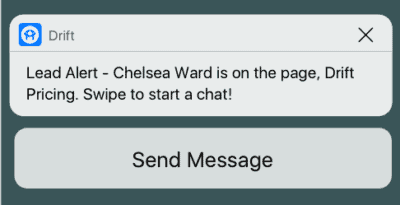
To quote an EverString blog post on Account-Based Marketing, “One conversation with a decision maker is more valuable than 20 unqualified leads”. ABM enables decision makers to be accurately identified and engaged with highly personalised content and messages. We believe that the future of Account-Based Marketing lies in the implementation of a third rocket: conversational marketing. Once you have identified the decision-makers, once they have been “warmed up”, you need to engage them in a conversation, to build a relationship as rich and personalised as your nurturing campaigns.
Account-based marketing has a bright future ahead of it. We strongly encourage you to test this approach in addition to your inbound marketing strategy. This will allow you to test its potential for your company.
